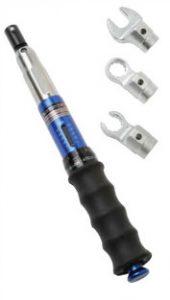Understanding Torque Values
 Generally, in the majority of applications, the reliability of the joint is dependent upon the bolts ability to clamp the parts together. Adequate clamping prevents relative motion between parts of the joint and leakage from joints containing gaskets. Measuring a bolts clamp force is difficult, especially under production assembly conditions.
Generally, in the majority of applications, the reliability of the joint is dependent upon the bolts ability to clamp the parts together. Adequate clamping prevents relative motion between parts of the joint and leakage from joints containing gaskets. Measuring a bolts clamp force is difficult, especially under production assembly conditions.
The clamp force generated by a bolt can be indirectly controlled by regulating the applied torque. This method, known as torque control, is by far the most popular method of controlling a bolts clamp force. The initial clamp force generated by the bolt is frequently called preload.
There is a link between the Torque applied to a bolt and the resulting preload. A problem exists in that friction has a large influence on how much torque is converted into preload. Besides the torque required to stretch the bolt, torque is also required to overcome friction in the threads and under the nut face. Typically, 10% to 15% of the torque is used to stretch the bolt. Of the remaining torque, typically 30% is dissipated in the threads and 50% to 55% under the nut face. Because friction is an important factor in the relationship between torque and preload, variations in friction have a significant influence on the bolts preload. Different bolt surface finishes generally have different friction values.
The Torque required for a socket head screw will not be the same as that required the same size standard hexagon bolt. The larger bearing face of the standard bolt will result in an increased torque being required compared to a socket headed screw. This is because more torque is being dissipated between the nut face and the joint surface.
 Stresses indicated into a Bolt: When a bolt is tightened the shank and thread sustain a direct (tensile) stress due to it being stretched. In addition, a torsional stress is induced due to the Torque acting on the threads. These two stresses are combined into a single equivalent stress to allow a comparison to be made to the bolts yield strength. In order to effectively utilize the strength of the bolt, yet leave some margin for any loading the bolt would sustain in service, an equivalent stress of 90% of yield is commonly used. It is this approach that is used in this guide.
Stresses indicated into a Bolt: When a bolt is tightened the shank and thread sustain a direct (tensile) stress due to it being stretched. In addition, a torsional stress is induced due to the Torque acting on the threads. These two stresses are combined into a single equivalent stress to allow a comparison to be made to the bolts yield strength. In order to effectively utilize the strength of the bolt, yet leave some margin for any loading the bolt would sustain in service, an equivalent stress of 90% of yield is commonly used. It is this approach that is used in this guide.
This approach has a number of advantages over the method where a direct stress, and hence preload value, is assumed in the bolt. For high thread friction values, a high torsional stress results in the bolt. Less of the available strength of the bolt is being utilized in such a case to generate preload. In the extreme case when a nut has seized on the bolt thread, all the applied torque is sustained as torsional stress with no preload being available. In the other extreme, low thread friction results in higher preloads.
Note! The information is provided to assist Engineers wishing to establish the theoretical Torque values because the preload and torque is dependent upon the friction values selected. The following information is given as a guide only. It is recommended that torque values derived from a formula should not be used without comparison to figures obtained using practical tests.
Source by: Mountz
